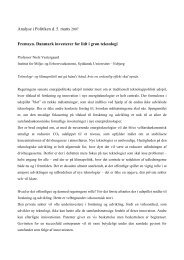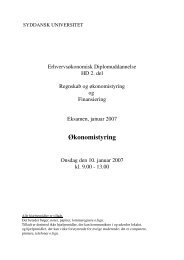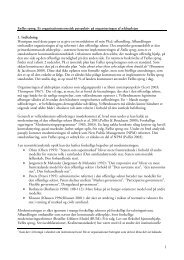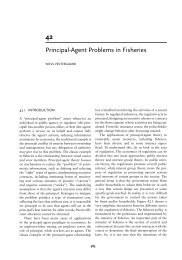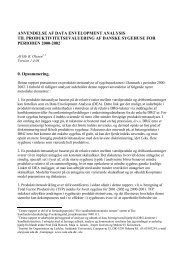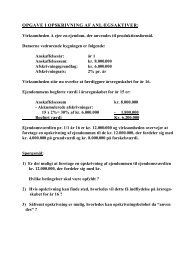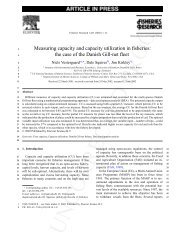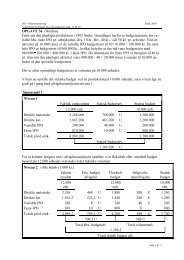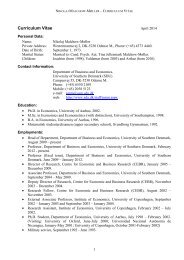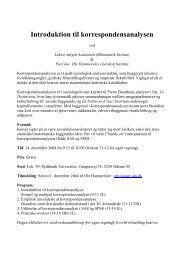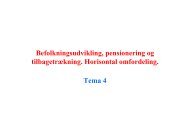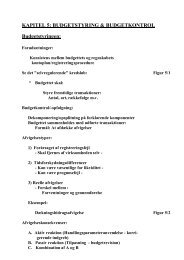Development of Parties and Party Systems in ... - lah@sam.sdu.dk
Development of Parties and Party Systems in ... - lah@sam.sdu.dk
Development of Parties and Party Systems in ... - lah@sam.sdu.dk
- No tags were found...
Create successful ePaper yourself
Turn your PDF publications into a flip-book with our unique Google optimized e-Paper software.
jobs <strong>in</strong> rural areas, especially small enterprises <strong>in</strong> the service sector <strong>and</strong> trades <strong>in</strong> stead <strong>of</strong> giv<strong>in</strong>gmore state support to small <strong>in</strong>efficient farmers.The peasant parties were strongly represented after the re-emergence <strong>of</strong> the Polish state after WorldWar I. At the first election <strong>in</strong> 1919 the three peasant parties, PSL, “Wyswolenie” PSL “Piast” <strong>and</strong>PSL “Lewica” together ga<strong>in</strong>ed 130, at the 1922 election 115 seats <strong>in</strong> parliament. After thecommunist take-over after WW II the United Peasants <strong>Party</strong> (ZSL) was established. That partyexisted <strong>in</strong> the whole communist period, cooperat<strong>in</strong>g with the rul<strong>in</strong>g communist party (PZPR). Soonafter the demise <strong>of</strong> real socialism, <strong>in</strong> May 1990, post-communist PSL “Odrodzenie” took thedecision to merge with PSL “Wilanowski”<strong>and</strong> form a new common party (PSL). PSL“Wilanowski’s” roots go back to Mikolajczyks peasant party, that after WW III dared to defy thecommunists <strong>and</strong> as a consequence <strong>of</strong> that was persecuted <strong>and</strong> <strong>in</strong> the end forbidden by theauthorities.Roman Bartoszcz, one <strong>of</strong> the founders <strong>of</strong> green Solidarity <strong>in</strong> 1980, was elected as leader <strong>of</strong> the newunited peasant party (PSL). At the outset the party was well <strong>in</strong>stitutionalised with a cemented partyorganisation <strong>and</strong>, accord<strong>in</strong>g to the party’s own calculations about 200.000 party members. After thedefeat at the 1990 presidential election Roman Bartoszcz resigned as the leader <strong>of</strong> the party <strong>and</strong> wasreplaced by the younger Waldemar Pawlak. At the 1991 election PSL won 8.67 percent <strong>of</strong> thevotes, at the 1993 election the share <strong>of</strong> the votes <strong>in</strong>creased to 15.5 pct. After the 1993 election PSLtook the decision to jo<strong>in</strong> the SLD led majority government. The majority was won because <strong>of</strong> thenew election law that raised the treshold requirement <strong>and</strong> was beneficial especially for big parties.At that election the Polish Right lost many seats <strong>in</strong> parliament due to the lack <strong>of</strong> election alliances.After the defeat at the 1997 Waldemar Pawlak resigned as the chairman <strong>of</strong> the party, but thedisagreements between the different factions <strong>in</strong>side the party were not elim<strong>in</strong>ated because <strong>of</strong> thechange <strong>in</strong> party leadership.Seen from the SLD the peasants party (PSL) better than other possible coalition partners may securea stable relationship to the church <strong>and</strong> the president (Walesa). In spite <strong>of</strong> the post-communist pastLech Walesa was less dismissive <strong>of</strong> cooperat<strong>in</strong>g with PSL than SLD. In addition, the <strong>in</strong>clusion <strong>of</strong>PSL <strong>in</strong> the government was considered a condition for obta<strong>in</strong><strong>in</strong>g the sufficient support from thePolish farmers. Op<strong>in</strong>ion polls from CBOS placed Waldemar Pawlak <strong>and</strong> PSL as a whole left to thepolical middle 61 . PSL establish strong clientelist networks <strong>in</strong> the rural areas <strong>and</strong> on voivod-level. Inthe first years the PSL members <strong>of</strong> parliament several times behaved differently at vot<strong>in</strong>g <strong>in</strong> theparliament, nonetheless until the 1993 PSL appeared like an opposition party to all the thenSolidarity led governments.The Peasants <strong>Party</strong> (PSL) has been a spokesman for go<strong>in</strong>g a “third way”. It supported the transitionto market economy, at least <strong>in</strong> words, but was at the same time underl<strong>in</strong>g the neccessity <strong>of</strong> morestate <strong>in</strong>tervention. More state <strong>in</strong>tervention may foster economic growth, secure more <strong>in</strong>vestments<strong>and</strong> structural reforms <strong>in</strong> education, pension systems, improve liv<strong>in</strong>g conditions <strong>in</strong> rural areas <strong>and</strong>strengthen local self-government. Unfortunately, old ideals <strong>and</strong> values, unelastic party programmes,irrational behaviour, veto party factions <strong>and</strong> <strong>in</strong>ternal disagreements about the policy l<strong>in</strong>e have beenbeen strik<strong>in</strong>g.PSL persistently acted as a lobbyist for agricultural <strong>in</strong>terests <strong>and</strong> has for that reason taken a criticalposition to the EU. The old municipal <strong>and</strong> regional structure that gave the party a considerable61 Spotkania 28 January-3 February 1993:13 <strong>in</strong> a special section about the Polish Left (”Lewa w marszu”.74



